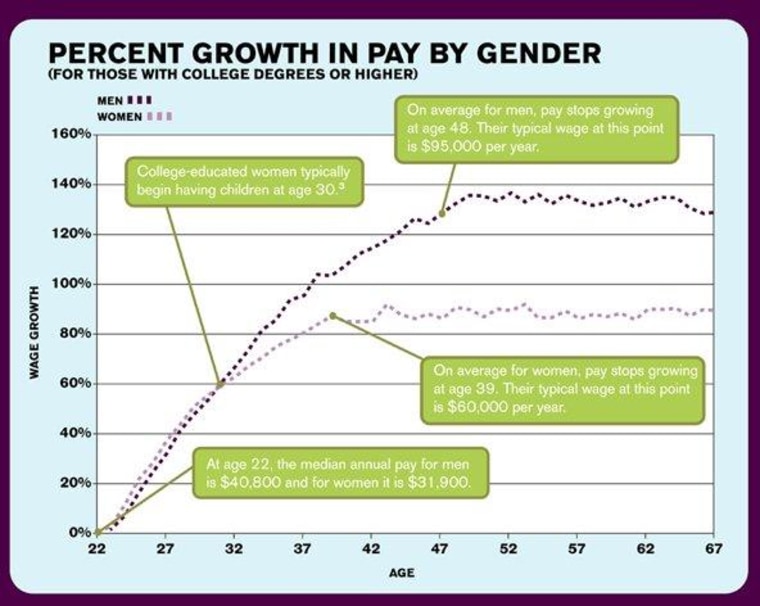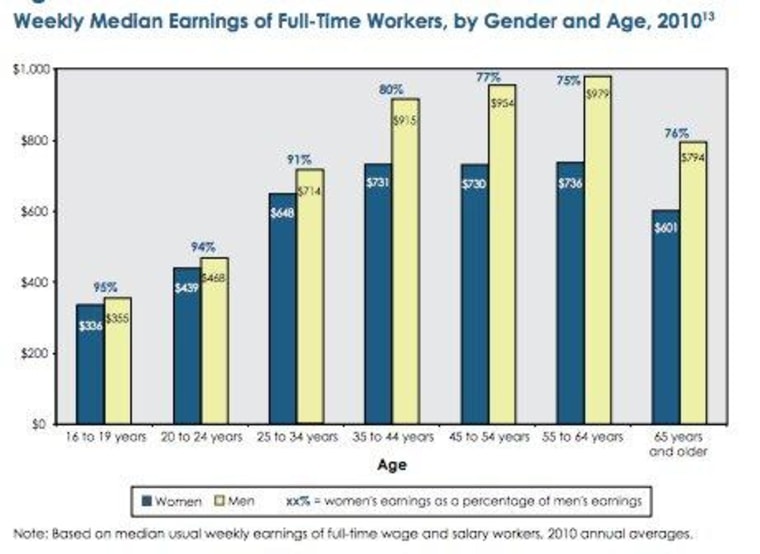Time doesn’t help working women when it comes to the gender pay gap.
On average, women with college degrees or higher see their pay stop growing at about age 39, while men continue to see wage increases until they’re 48, according to a new report by PayScale, an online compensation data company.
That means the wage gap between women and men that begins in early in their careers gets bigger as they age. The PayScale data, which are based on compensation information from 1.6 million profiles submitted by users of the firm’s website, found that women make a median yearly salary of $31,900 at age 22, compared to $40,800 for men; and by their late 40s women are bringing in about $60,000 to the $95,000 average yearly wage men get.

“Male pay is higher, and grows higher and grows faster than female pay over time,” said Katie Bardaro, lead economist for PayScale.
But, she added, much of the discrepancy among the sample they reviewed came form the types of jobs women chose. Women are opting for lower-paying jobs, including everything from human resources to nursing, compared to male choices that are more often higher-paying occupations such as finance and engineering.
Other research has found similar patterns in pay over time, but some studies uncovered a pay difference even when such factors as types of jobs were accounted for.
Catherine Hill, research director of the American Association of University Women, said PayScale’s findings are somewhat limited because they don’t look at the entire population.
Hill’s research, looking at national government data, also shows a growing gap in pay as women grow older. When she compared apples to apples as far as career choices, the disparity remained, albeit smaller.

“We found a pay gap one year out of college among full-time workers where women earned 80 percent as much as their male peers just one year out of college,” she explained. “Then we analyzed all the things that impact earnings such as job choice, GPA, the school they went to, etc. When all’s the same there’s still a 5 percent gap.”
Fast forward ten years, she continued, and the women earn 69 percent as much as their male counterparts. And when the data was controlled for things such as having kids, or taking time out of the workforce, there still was a 12 percent gap in pay between men and women, she noted.
The issue pay gap issue is critical given the ongoing national debate and also pending legislation to address income inequality among men and women. The Paycheck Fairness Act, which failed to pass in 2010, was put to a vote on Thursday in the House and legislators decided not to consider the act. The Senate is expected to vote on the bill Tuesday. The bill would boost remedies for victims of pay bias and also mandate that employers justify pay differences.
“I think it can be very helpful,” Hill said, about legislation that would help close the gender pay gap. “The best employers are doing things they should when it comes to pay but it would be a reminder for all those other employers to catch up.”
There are many reasons for the gap, said Teresa Boyer, executive director of the Center for Women and Work at the School of Management and Labor Relations Rutgers.
“There is simple mathematics,” she said. “Even if you start behind just a little bit that exponentially grows. If you start out with a $1,000 pay difference, over time it can become tremendous, just like compounded interest but in reverse.”
Also, she said, when you look at women’s career trajectories, including things like promotions and positions in the corner offices, women tend to lag behind men.
And there is the issue of choices made when it comes to family obligations, she said, where some may take time off, or pare down careers after having children. But she stressed, “you can’t assume women are making these choices in a vacuum.”
Women often feel they are the only ones to take on responsibility and as a result make changes to their career ambitions because employers give them few options in terms of flexible schedules that could help them stay on the ladder of success.
She pointed to a report released by Pew Research Center in April that found 64 percent of women ages 18 to 34 said being successful and securing a good-paying job was very important or one of the most important things in their lives.
Women, she stressed, “have the desire to be successful and make money.”